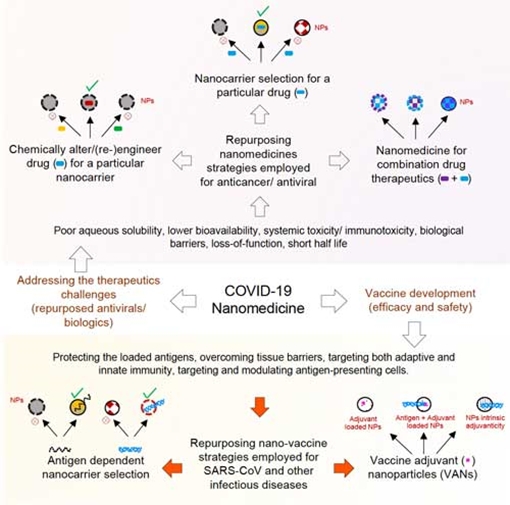|
NOVIDADES
Notwithstanding the wishful thinking of certain irresponsible and incompetent public figures, the only options to control and deal with the spread of the Severe Acute Respiratory Syndrome Virus 2 (SARS-CoV-2) are fast, cheap, reliable, and portable means of diagnosing COVID-19 infection (the name of disease caused by SARS-CoV-2); therapeutics to treat the infected; and vaccines to rapidly build up immunization of large parts of the global population. In a previous Nanowerk Spotlight we covered nanotechnology-based approaches to testing for COVID-19 infections in high-risk individuals. Today we look at the role of nanotechnology in countering the conventional limitations of antiviral and biological therapeutics. Nanocarriers also have potential to design risk-free and effective immunization strategies for SARS-CoV-2 vaccine candidates such as protein constructs and nucleic acids. A review paper in ACS Nano ("Nanotechnology for COVID-19: Therapeutics and Vaccine Research") provides systematic information on nanomedicine strategies employed to deliver small molecules, biologicals (specifically RNAi) and various combination therapies. Some strategies are also proposed for the rational development of this nanomedicine approach and its clinical translation. Since most of the COVID-19 vaccine candidates are sophisticated biological moieties (DNA, mRNA, recombinant proteins, engineered APCs etc.), the scope of nanocarrier delivery becomes highly pertinent. The authors first describe in great detail the current state of knowledge about the virus's life cycle, pathophysiology and structure, and then address the organ systems primarily affected by SARS-CoV-2 (it affects the respiratory system first and then spreads systemically to the heart, liver and kidney). Using recently available genetic information and protein structure modelling, several therapeutic strategies based on drug repurposing are projected for the immediate treatment of infected patients. According to the authors, target identification to halt the pathogenesis of the viral infection holds the key in this development: "Viral protease (3CLpro and PLpro), host cell produced protease (TMPRSS2), RNA polymerase (RdRp), interaction site of viral S protein with host receptor ACE2 are among the major targets identified for repurposing already existing antiviral molecules and new small molecules under development." Other proposed strategies are targeting the SARS-CoV-2 surface S protein using neutralizing antibody (nAbs) and targeting the SARS-CoV-2 viral RNA genome using RNA interference (RNAi) or antisense oligonucleotides. Developing a vaccine against COVID-19 Massive efforts are being employed across the world to develop safe and effective vaccines and several vaccine candidates (see Table 1 in the review for details) have already made it to human clinical trials as a result of fast-tracked development strategies and advanced vaccine technological platforms (read more here in The New England Journal of Medicine: "Developing Covid-19 Vaccines at Pandemic Speed"). Massive efforts are being employed across the world to develop safe and effective vaccines and several vaccine candidates (see Table 1 in the review for details) have already made it to human clinical trials as a result of fast-tracked development strategies and advanced vaccine technological platforms (read more here in The New England Journal of Medicine: "Developing Covid-19 Vaccines at Pandemic Speed"). Similar to what researchers are doing in developing SARS-CoV-2 therapeutics, the target strategy for most of the vaccine candidates is to induce nAbs against the viral S protein, averting the ACE2 mediated host uptake. In the case of SARS-CoV vaccine development, higher nAbs titers and better protection was reported with S protein subunit vaccines when compared to any other target strategy. SARS/MERS vaccine development research suggests S protein subunits, RBD of the S1 subunit and S protein/gene as the most preferred target sites. The development of COVID-19 vaccine candidates are relying on several high-tech platforms including attenuated and inactivated viruses, replicating and non replicating viral vectors, DNA and mRNA, virus-like particles and recombinant protein-based approaches. The authors make an effort to systematically present the current status of nanotechnology use in therapeutics and vaccine development. They note that therapeutic development and challenges against SARSCoV-2 infection are not so different from other infectious diseases as well as oncology research. Similarly, the vaccine development holds significant commonalities with strategies explored against previously known SARS and MERS coronaviruses. Hence, they write, it is worth revisiting these closely related therapeutic and vaccine strategies and associated nanotechnologies use in order to design 'repurposed nanotechnology' to fast-track the current research.  Nanomedicine strategies for COVID-19 therapeutics and vaccine development. Reprinted with permission by American Chemical Society
They also point out that the scope of nanotechnology for COVID-19 therapeutics and vaccine research is not limited to conventional therapeutic and vaccine designs. Several other approaches including advanced nanomaterial and biomimetic approaches represent promising opportunities in a COVID-19 like outbreak. Summing up their review, the authors conclude that nanotechnology tools can play a pivotal role in advancing COVID-19 treatment and vaccine development and that information related to the structural morphology of the SARS-CoV-2 virus, its pathophysiology and related immunological response is vital for nanotechnology scientists. By Michael Berger – Michael is author of three books by the Royal Society of Chemistry: *Nanotechnology: The Future is Tiny, Nanoengineering: The Skills and Tools NW. Posted: June 26, 2020.
|
|||||||||||||||||||||||||